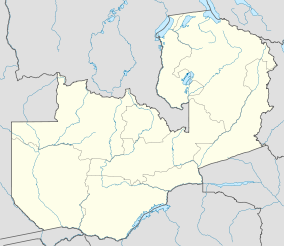
Kafue National Park
Background Information
SOS Children has tried to make Wikipedia content more accessible by this schools selection. All children available for child sponsorship from SOS Children are looked after in a family home by the charity. Read more...
| Kafue National Park | |
|---|---|
|
IUCN category II ( national park)
|
|
| Location | Zambia |
| Coordinates | 15°46′S 25°55′E Coordinates: 15°46′S 25°55′E |
| Area | 22,400 km² |
| Established | 1950s |
Kafue National Park is the largest national park in Zambia, covering an area of about 22,400 km² (similar in size to Wales or Massachusetts). It is the second largest park in Africa and is home to over 55 different species of animals.
The park is named for the Kafue River. It stretches over three provinces: North Western, Central and Southern. The main access is via the Great West Road from Lusaka to Mongu which crosses the park north of its centre. Seasonal dirt roads also link from Kalomo and Namwala in the south and south-east, and Kasempa in the north.
History
Kafue National Park was established in 1924 after the British colonial government moved the traditional owners of the area, the Nkoya people of (King) Mwene Kabulwebulwe, from their traditional hunting grounds into the Mumbwa District to the east. Dissatisfaction with the pace of development in Central Province and a lack of benefit from tourism in the park have led to calls from Nkoya leaders to establish a new province in the area which they have proposed to call Kafue Province.
Ecoregions and habitats
Most of the park lies in the Central Zambezian Miombo woodlands ecoregion characterised by savanna grasslands with Miombo tree species, growing thickly in some patches, with a few small dambos (grasslands which become marshy in the rainy season) interspersed among them. In the south there are stony hills and rocky outcrops where the sparser Zambezian and Mopane woodlands ecoregion takes over, and Mopane trees adapted to hotter drier conditions replace Miombo. A thin belt of evergreen forest lines the banks of the Kafue River, which has been controversially dammed just outside the park at Itezhi-Tezhi Dam, forming a reservoir within the park. Patches of Baikiaea (teak) and Cryptosepalum evergreen forest occur in the south and west.
The jewel in Kafue's crown however is the Zambezian flooded grasslands ecoregion in the north, including the Busanga Swamp and plains. These support large herds of herbivores and their predators. In the dry season the animals keep close to the swamps and marshy creeks and are easily seen. The area is also noted for its birdlife.
Ngoma in the south is the headquarters of the park but this area together with the Nanzhila Plains are less visited and have become somewhat run down since the Itezhi-Tezhi Dam was built and more lodges were developed in the north. The reservoir cut the north-south track through the park and now it is necessary to detour outside the park to drive between Ngoma and Chunga.

